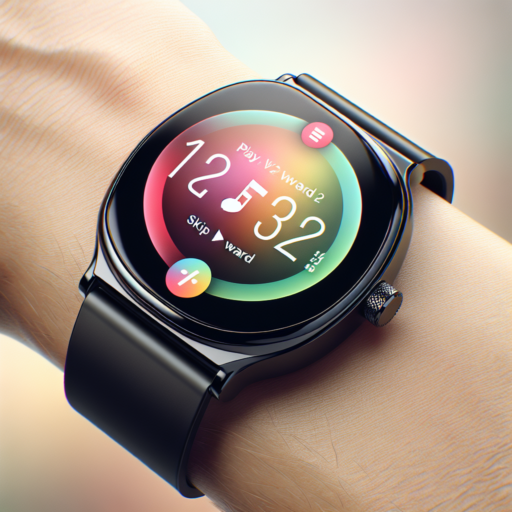How to Choose the Right Smartwatch for Playing Music Without a Phone
Choosing the right smartwatch for playing music without a phone involves considering several key features that enhance the user experience. When embarking on this selection journey, it’s vital to focus on models that prioritize standalone music playback capabilities, ensuring that your music journey is seamless and enjoyable, even without your phone.
Consider Battery Life and Storage Capacity
The first step in selecting the perfect smartwatch is to evaluate its battery life and storage capacity. Smartwatches with long battery life ensure that you can enjoy continuous music playback without frequent charging interruptions. Equally important is the storage capacity, which determines how many songs you can store directly on your smartwatch. Look for watches that offer at least 4GB of storage, allowing you to keep a substantial music library at your wrist.
Look for Dedicated Music Streaming Apps
An essential feature for music enthusiasts is the availability of dedicated music streaming apps on the smartwatch. Platforms like Spotify, Apple Music, and Deezer often have standalone apps for smartwatches, enabling users to stream music directly to their wrist without needing a smartphone nearby. Check for compatibility with your preferred streaming service to ensure a smooth and enriching listening experience.
Assess Audio Connectivity Options
Finally, assess the smartwatch’s audio connectivity options. A smartwatch optimized for playing music without a phone should offer versatile audio connectivity, such as Bluetooth for wireless headphones or built-in speakers for immediate listening. This flexibility enhances your music experience, allowing for private or shared listening whenever you choose.
The Top Smartwatches for Listening to Music Without Your Phone in 2023
In the era of wireless technology, the demand for a seamless, phone-free music experience is growing. As such, smartwatches have evolved, offering more than just time-keeping and fitness tracking. The year 2023 sees a wave of innovative devices designed to keep your favorite tunes playing, no matter where you are, without the need to carry your phone. Below, we delve into the key features that set these smartwatches apart in the realm of music playback.
Standalone Music Storage: One of the paramount qualities of a smartwatch suited for music lovers is its ability to store music directly on the device. This allows for offline listening during activities where carrying a phone is impractical. Modern smartwatches come with sizable internal storage, offering ample space to keep a diverse playlist right on your wrist.
Connectivity and Streaming: Advanced connectivity options are a must for seamless access to streaming services. The leading smartwatches of 2023 boast built-in WiFi and cellular capabilities, enabling you to stream music from popular platforms like Spotify and Apple Music without needing a phone nearby. Bluetooth connectivity further ensures uninterrupted playback through wireless headphones or earbuds, providing a truly cable-free experience.
Overall, the capacity for a smartwatch to offer a robust music-listening experience without the tether of a phone has become a key factor for consumers in 2023. As technology advances, we anticipate even more innovative features enhancing this aspect of smartwatch functionality in the near future.
Step-by-Step Guide: How to Play Music on Your Smartwatch Without a Phone
Playing music on your smartwatch without a phone seems like a futuristic idea, but it’s a functionality that exists today for many smartwatch models. Whether you’re going for a run, hitting the gym, or just want to enjoy music without the bulk of a phone, your smartwatch has got you covered. Let’s dive into the essential steps to kickstart your phone-free music experience.
1. Download Music Apps Directly to Your Smartwatch
Firstly, browse through your smartwatch’s app store to find and install your preferred music streaming apps. Popular options like Spotify and Apple Music often have versions compatible with smartwatches. Make sure your device is connected to Wi-Fi to download and install these apps smoothly. This step is crucial for setting the stage for a seamless music experience directly from your wrist.
2. Sync Your Favorite Playlists
Once you’ve got the apps installed, it’s time to sync your favorite playlists. Depending on the app, you may need to do this from your phone or directly on the watch. Ensure your playlists are downloaded to the smartwatch so you can access them offline. This way, even when you’re out of Wi-Fi range or don’t want to consume data, your music is just a tap away.
3. Connect to Bluetooth Headphones
Finally, to enjoy music from your smartwatch, you’ll want to pair it with Bluetooth headphones or earbuds. Navigate to your smartwatch’s settings, find the Bluetooth options, and start the pairing process. Once connected, launch your music app, select your playlist, and immerse yourself in your favorite tunes without any cords or phones to hold you back.
Comparing the Best Smartwatches for Music: Storage, Battery Life, and Features
When it comes to integrating music into our daily routines, smartwatches have become indispensable for many. With a plethora of options available, selecting the right smartwatch that marries ample storage, enduring battery life, and innovative features can seem daunting. This comparison delves into the critical aspects that make a smartwatch ideal for music aficionados.
Storage capability is paramount when considering smartwatches for music. Devices now offer a range from 4GB to over 32GB, allowing users to store thousands of songs directly on their wrist. The freedom to carry an extensive playlist without the need for a phone connection is a luxury for active lifestyles. Examination of top-tier models reveals a trend towards increased storage capacities, catering to the growing demand for offline music playback capabilities.
Equally crucial is battery life. A smartwatch should sustain through your daily activities without the constant need for recharging, especially when relying on it for music during workouts or commutes. High-performing models boast battery lives that extend beyond a day, with some even pushing the boundary to a week under specific usage conditions. This endurance ensures that your music, alongside other functionalities, remains uninterrupted.
Lastly, the features that enhance the music listening experience cannot be overlooked. Innovations such as Bluetooth connectivity for wireless earbuds, on-the-go streaming applications, and built-in speakers are now standard. Additionally, the integration of voice assistants and waterproof designs add layers of convenience and versatility, making the music experience seamless and more enjoyable.
Offline Music on Smartwatches: How to Listen Without an Internet Connection
Can You Really Enjoy High-Quality Music on a Smartwatch Without Your Phone?
Offline Music on Smartwatches: How to Listen Without an Internet Connection
Listening to music has transitioned from stationary record players to the compact and wearable design of smartwatches, offering the convenience of having your playlists right on your wrist. The question that arises is, can you enjoy high-quality music on a smartwatch without carrying your phone around? The simple answer is yes. The evolution of smartwatch technology now allows users to store music directly on their devices. This means you can leave your phone at home and still have your music with you, making it the ideal companion for workouts, runs, or even just for a break from screen time.
How to Set Up Your Smartwatch for Offline Music Playback
To begin enjoying your tunes offline, the initial step involves transferring music files from your phone or computer directly to your smartwatch. Most smartwatches come with a certain amount of storage dedicated to music. For instance, apps like Spotify and Apple Music offer options to download playlists directly to your device, ensuring that you can access your favorite songs without needing any data or wifi connection. It’s a seamless process that enhances the functionality of your smartwatch, turning it into a standalone music player.
The Importance of Sound Quality and Storage Capacity
While the convenience of offline music on smartwatches is undeniable, two critical aspects significantly influence the user experience: sound quality and storage capacity. Modern smartwatches are equipped with high-quality music codecs that ensure the sound is crisp and clear, rivaling that of smartphones. Additionally, choosing a smartwatch with ample storage is essential as high-quality music files can quickly consume space. By prioritizing these factors, users can truly enjoy a rich and immersive listening experience without any compromises.
The Pros and Cons of Using Your Smartwatch as a Standalone Music Player
When considering using your smartwatch as a standalone music player, it’s important to weigh the benefits and drawbacks meticulously. This approach to enjoying music has gained traction, thanks to the technological advancements embedded in our everyday wearables. Making an informed decision requires understanding both sides of the equation.
Pros of Using a Smartwatch for Music Playback
- Convenience: The primary advantage of using a smartwatch as a music player lies in its convenience. The compact and wearable nature of smartwatches allows users to access their favorite tunes without the need to carry an additional device.
- Integration with Fitness Activities: Most smartwatches are designed with fitness tracking capabilities. This seamless integration enables users to listen to music while monitoring their workout sessions, enhancing the overall exercise experience.
- Wireless Operation: The ability to connect to Bluetooth headphones or earbuds wirelessly means you can enjoy a tangle-free listening experience, making it ideal for both everyday use and physical activities.
Cons of Using a Smartwatch as a Music Player
- Limited Storage Capacity: Compared to dedicated music players or smartphones, smartwatches often offer significantly less storage space, which can be a major drawback for music enthusiasts wanting to store a large library of tracks.
- Battery Drain: Playing music directly from your smartwatch can lead to quicker battery depletion. Users may find themselves needing to recharge their device more frequently, which can be inconvenient, especially during long days out or when traveling.
- Sound Quality: While the convenience of a smartwatch is undeniable, the sound quality, when compared to that of specialized music devices, might not meet the expectations of audiophiles. This can be a significant downside for those who prioritize audio quality over convenience.
How to Extend Battery Life While Playing Music on Your Smartwatch Without a Phone
Playing music directly from your smartwatch is a convenient feature for active users. However, this functionality can significantly drain your device’s battery life. To ensure your smartwatch keeps up with your lifestyle without being tethered to a phone, consider these effective strategies to maximize battery longevity while enjoying your favorite tunes.
Optimize Your Smartwatch’s Settings
First and foremost, optimizing your smartwatch’s settings is critical. Start by adjusting the screen brightness to a lower level that is still comfortable for you to read. Many smartwatches also offer a battery-saving mode that automatically tweaks various settings to extend battery life. Engaging this mode while playing music can make a noticeable difference. Additionally, turning off unnecessary notifications and features that you don’t need when listening to music can save a significant amount of power.
Manage Your Music Playback Efficiently
Another way to conserve battery life is by managing your music playback efficiently. Creating playlists ahead of time reduces the need for your smartwatch to use power searching for songs or streaming from the cloud. If your smartwatch allows, download a few playlists directly to your device. Playing music from local storage is far more battery-friendly than streaming over a Wi-Fi or cellular connection. Remember to periodically review and update your playlists to keep your music fresh without constant streaming.
Lastly, be mindful of the volume level at which you play music. Higher volume levels can drain the battery more quickly, not just because of increased power draw by the speaker or connected headphones but also due to the higher processing power required. Keeping the volume at a moderate level will ensure a balanced battery consumption. By implementing these tips, you can significantly extend your smartwatch’s battery life, ensuring you’re never without your music or notifications during your daily activities.










